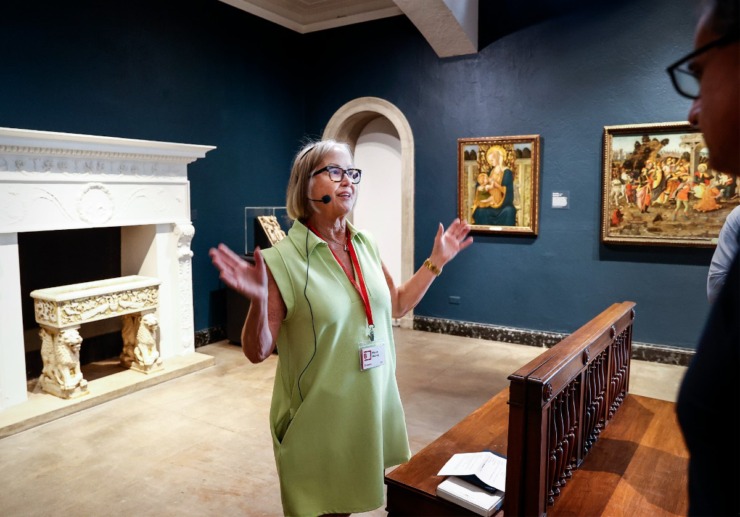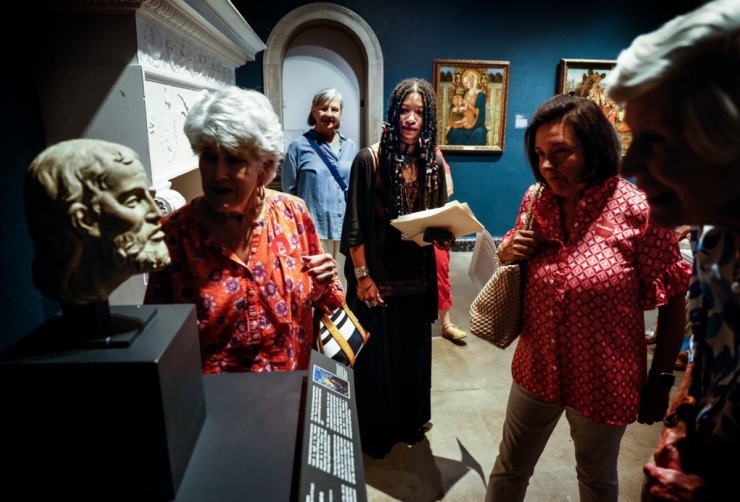|
The Arts Beat is a weekly deep-dive into Memphis arts, music, dance, theater, fashion, film and events. Keep scrolling for a roundup of the best arts and culture stories from the week. Have a story idea? Send it to eperry@dailymemphian.com.
The Memphis Brooks Museum of Art needs more docents.
What is a docent? Docents are trained museum guides, usually volunteers.
During its 2025 fiscal year, Brooks Museum docents gave 328 tours and volunteered for 1,409 hours.
Docent coordinator Kate Langley says good docents have a desire to constantly learn, want to talk to people and have an interest in community.
“A lot of people are nervous when becoming a docent or showing interest in the program if they don’t have an art background,” she said.
“But I think really those are some of the best docents that we have, that come in with no prior art knowledge. Just because they are people who are really excited about learning new things and jumping into something that’s completely unknown to them.”
Want to volunteer at the Brooks Museum?
The Brooks Museum docent program dates back to 1965. Docents train for four months with two classes per week, then make a two-year commitment to volunteer a few times a month.
The training currently includes a 12-week art history class taught by University of Memphis associate professor William McKeown, and what Langley refers to as “experiential learning.”
The trainees shadow current docents, start building tours and workshop tours with others.
Docents attend monthly training meetings and are trained on the museum’s temporary exhibitions before the show opens.
“We don’t do scripts or any specific objects that have to be shown,” Langley said.
 Brooks Museum volunteer docent Maria Kulma (middle) leads the “The Evolution of Artistic Mediums,” tour on Thursday, July 17, 2025. (Mark Weber/The Daily Memphian)
The Brooks Museum has two docent tracks, one with its longstanding school-tour docents and another with its newer public-tour docents.
Applications are open for both programs.
Story continues below
Top art and culture stories
Brooks Museum shares art with 20,000 children each year
Like the name implies, school tour docents help with school tours at the museum.
The museum serves 20,000 school-aged children annually across all its education programs.
That is expected to rise to 30,000 when the Brooks Museum moves Downtown and becomes the Memphis Art Museum.
The Brooks Museum’s biggest need is for school tour docents, who are needed during the day when students visit the museum.
Thus, the school-tour docents are primarily retirees. Many have been volunteering for more than a decade, Langley said.
“Once the school year starts, we’re doing at least one (school) tour every day, Wednesday through Friday, for the entire school year, so we rely really heavily on them,” she said.
Anne Whirley, the museum’s 2025 Docent of the Year, has been a school tour docent since 2022.
Whirley is a retired special education teacher. She taught for three decades.
“I really like children,” she said.
She heard about the docent program on WKNO and thought, “I’d like to do that.”
Her only prior experience with art was an art appreciation class in college.
“It’s really surprising how many kids have never been to a museum before, but they’re all engaged and well-behaved,” Whirley said of her tour experience.
Memphis-Shelby County Schools' Discovering Memphis initiative allows each student to visit a cultural institution during the year. So, for the past two years, the Brooks Museum has seen a lot of seventh graders during tours.

Whirley said her fellow docents are from a variety of backgrounds, but have an “enjoyment of art” in common. They also go on field trips together.
She and other docents have visited the Dixon Gallery & Gardens, the Frist Museum in Nashville, the Arkansas Museum of Fine Arts in Little Rock, and the Teapot Museum in tiny Trenton, Tennessee.
“Every place we’ve gone ... their docents have taken us around, and just been really good hosts for us,” Whirley said. “And it’s been just such a nice outing to go on and see how other people do it and what’s available, what’s out there.”
For the Teapot Museum tour, Whirley said, the Trenton mayor served as the docent for the Brooks Museum group.
Public-tour guides serve on nights and weekends
The other docent track at the Brooks Museum is for public tours, for people who can volunteer on nights and weekends. Young professionals, “people at the top of their careers,” and stay-at-home parents are attracted to the program, Langley said.
 Brooks Museum volunteer docent Kaitlyn Curry (middle) leads the “The Life of Jesus Christ through Art,” tour on Thursday, July 17, 2025. (Mark Weber/The Daily Memphian)
The first public-tour docent class began in September 2024, with the docents graduating in January 2025. Langley said 10 people from the new class are actively giving tours.
One of those new public-tour docents is Lola Johnson.
Johnson gave her tour, “Beauty Standards and Fashion Evolution,” in early July.
She describes the tour as the evolution of beauty standards and socioeconomic statuses associated with that. The tour covers the 1600s to the present day.
The Memphis native said she had been looking on the Brooks Museum website for opportunities to volunteer with kids and came across the docent program.
Johnson had to Google what a docent was. After that, she went to an interest meeting.
Johnson has had a long appreciation for art and had taken an art history class while attending Mississippi State as an industrial engineering major.
Johnson said she was always creative growing up, but chose the engineering route for financial stability.
But she never stopped creating art.
Her experience spans from makeup for editorial spreads, creative direction, fashion styling, fashion design, photography and DJing (as DJ Brillianaire). Her platform showcasing Memphis creatives is called Friends with Imagination.
Johnson has had pieces in a Brooks Museum fashion show. She both DJed and organized an event at the Brooks Museum featuring three other female DJs for Women’s History Month in March.
“Art is pretty much the center of my life,” Johnson said. “To keep my life fun and interesting, things like the docent program, they add to that. You have a community within that. You get to go to the Brooks. You get to network.”
Public-tour docents choose their own tour themes
Langley described the public tour docent experience as more “self-directed.”
They have three months of training and during the fourth month learn how to research art objects. Public-tour docents are tasked with brainstorming a theme and selecting objects that are varied, and building conversation guides and tours.
They shadow current docents, start building tours and workshop tours with other docents in their cohort.
They give sample tours to affinity groups that they’re in, then friends and family, and finally give a tour to the docent coordinator and director of education.
After they’re given notes, they get on the recurring docent tour schedule.
“They’re really varied,” Langley said. “... There’s an onus on (the docents) to do what they’re interested in and do their own research. They really get to create something they’re interested in and that’s the audience members in the museum are much more interested because they’re so personally invested in what they’re talking about.”
The ideal number of public-tour docents, Langley said, is 40, which will take some time to develop.
Forty would allow the museum to develop a daily tour schedule for visitors.
Those interested in school tours or public tours can read more information on the Brooks Museum’s website and fill out an interest application.

..... |